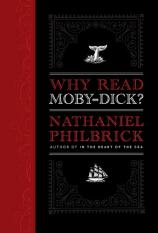Why Read Moby-Dick?
Review
Why Read Moby-Dick?
WHY READ MOBY-DICK? may be better titled “Why Re-Read Moby-Dick?” As students, all of us were subjected to what many consider the Great American Novel. My experience came in junior high school, and the passage of many decades does not dim the excruciating boredom I felt when reading Herman Melville’s epic tome. The passing years exposed me to other Melville literature, specifically the novella “Billy Budd” and the short story “Bartleby, the Scrivener.” At a used book sale several years ago, I came across a beautiful copy of MOBY-DICK. The edition contained stunning illustrations and leather binding. By this time, my children were reading it in their literature classes, and I was enticed to buy it. I decided that perhaps Melville and the great white whale deserved another chance. I was not disappointed.
"More than a dozen readings of MOBY-DICK inspired Philbrick’s brief but thorough study of what makes Melville’s classic so endearing. Along the way, he provides readers with an excellent complement to the epic novel."
Nathaniel Philbrick’s historical studies have often been sea-related. IN THE HEART OF THE SEA, published in 2000, was the story of a Nantucket whaling ship that, on an expedition to the Pacific in 1820, was attacked and sunk by a sperm whale. The saga of the ship, The Essex, was believed to be the inspiration for Melville’s novel, published in 1851. Philbrick’s maritime history of the tragedy won a National Book Award. More than a dozen readings of MOBY-DICK inspired Philbrick’s brief but thorough study of what makes Melville’s classic so endearing. Along the way, he provides readers with an excellent complement to the epic novel. And after reading over 800 pages, an additional 127 cannot be too taxing.
In a series of 28 essays, Philbrick covers an extensive number of thought-provoking topics. Commencing with some brief introductory information, he notes that MOBY-DICK was far from an instant classic. The book was actually a flop when it was originally published. Indeed, in 1891 when Melville died, the book had sold a grand total of 3,715 copies. Not until post-World War I did it begin to garner accolades from a new generation of Americans. William Faulkner called it the one novel by another author that he wished he had written. In 1949, Ernest Hemingway told his publisher that Melville was one of the few authors he was still trying to beat. Philbrick notes that the novel grows on you. It is encyclopedic in nature and a repository of American history and culture.
The Pequod is the vessel that transports the characters who live in the pages of the novel. In Philbrick’s mind, the ship is the mythic incarnation of America in the 1850s --- a country blessed by God and believing in the free enterprise yet still embracing signs of barbarity. From its wealthy owners to the exploited laborers, the crew embodies the nation. For Philbrick, it is the continued importance of numerous contemporary social and political issues that makes MOBY-DICK as vibrant today as it was when Melville initially put pen to paper.
While the continuing vitality of Melville’s themes are essential, Philbrick also takes time to direct readers to the beautiful and poetic quality of Melville’s writing. MOBY-DICK contains passages with vivid descriptions ranging from the sea to clam chowder. There is a great deal more packed into the few pages of Philbrick’s tribute. But discussion of those observations is not his primary intent. Philbrick has a more important goal; he wants you to read MOBY-DICK. Take his advice, whether for the first, second or even 10th time.
Reviewed by Stuart Shiffman on October 20, 2011
Why Read Moby-Dick?
- Publication Date: October 20, 2011
- Genres: History, Literary Criticism, Nonfiction
- Hardcover: 144 pages
- Publisher: Viking Adult
- ISBN-10: 0670022993
- ISBN-13: 9780670022991





